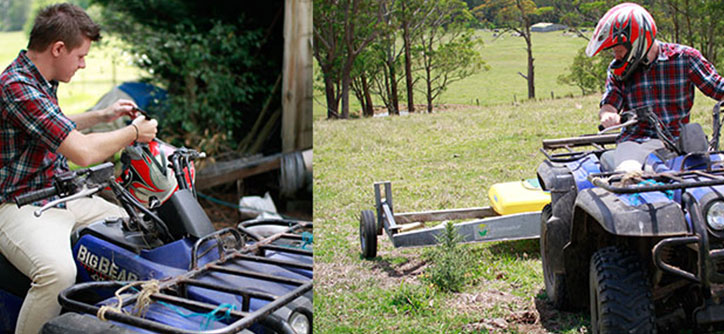Incidents involving quads are now the leading cause of injury death on Australian farms. Most deaths are due to crush injury and/or asphyxiation associated with quads rolling over, or by injury associated with the victim being flung onto a hard surface as a result of a crash. Farmsafe Australia partners urge businesses to think carefully about the use of quads on their workplaces, taking into account the safety risks.
Growers who are employers or in control of the workplace have responsibility under Work Health and Safety (WHS) law to provide safe systems of work for workers and visitors to the workplace, including operation of quads.
To best manage safety in quad and side-by-side vehicle operation on Australian farms and to meet WHS obligations, employers should consider :
1. Machine or vehicle selection
Where possible select a machine that has a low risk of rollover. Consider the machines that can be fitted with a suitable operator protective device, including rollover protective structure and operator restraint. Many jobs on the land can be undertaken using alternative vehicles to quads. If using a quad, fit a tested crush protection device.
2. Conditions of operation
Specify the jobs for which the quad/side-by-side vehicle is to be used, the conditions of operation (including speed and load and tow limits), the areas on the property on which the machine is to be operated and define “no-go” areas.
3. Attachments and loads
The instability of quads makes them unsuitable for carrying loads or towing. For side-by-side vehicles make sure that attachments and loads comply with the specifications in the Operator’s Manual, taking into account that loads will reduce stability. This information should be available from the supplier.
4. Quads and passengers
Do not allow passengers on quads.
5. Quads and children
Do not allow children under 16 years to operate or be carried as passengers on quads of any size.
6. Training operators of quads and side-by-side vehicles
Make sure that operators of quads/side-by-side vehicles are trained to operate the machine safely.
7. Induction to safe operation of quads/side-by-side vehicles
Make sure that operators receive a thorough induction to safe operation of the vehicle on the specific property.
8. Maintenance
Ensure that machines are well maintained and in good working condition for safe operation.
9. Helmets
Provide a suitable helmet and ensure that it is worn.
10. Supervision
Supervise safe operation.
Source: Australian Center for Agricultural Health and Safety




